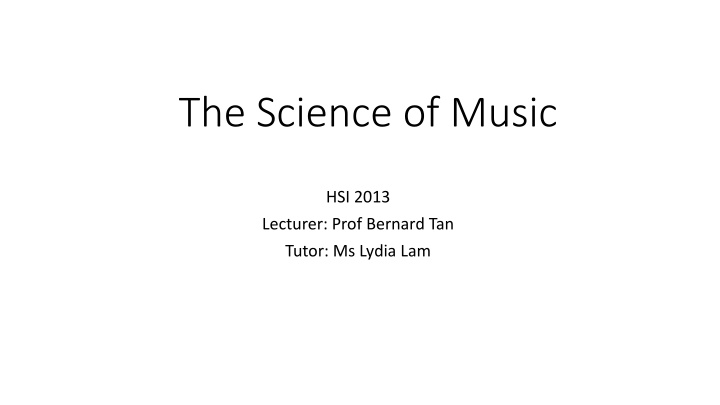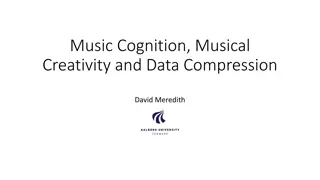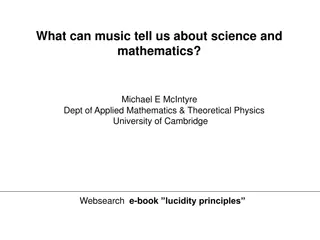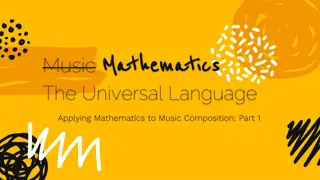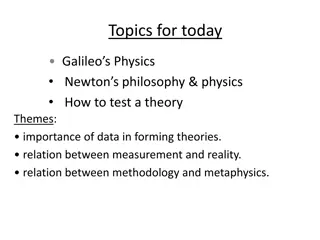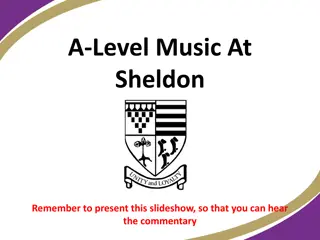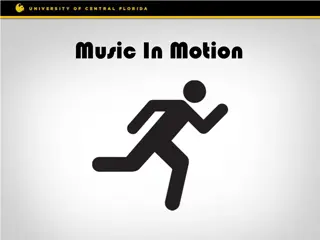Exploring the Science of Music: The Intersection of Physics, Mathematics, and Technology
Delve into the intricate relationship between science and music through the lens of physics, mathematics, and modern technology. Discover how musical scales, waveforms, and sounds are intertwined with scientific principles and advancements. Unveil the evolution of music through the exploration of musical instruments, harmonics, and electronic synthesis. Gain a deeper appreciation for the profound impact of scientific inquiry on the realm of music and how technology has revolutionized its creation and dissemination.
Download Presentation

Please find below an Image/Link to download the presentation.
The content on the website is provided AS IS for your information and personal use only. It may not be sold, licensed, or shared on other websites without obtaining consent from the author.If you encounter any issues during the download, it is possible that the publisher has removed the file from their server.
You are allowed to download the files provided on this website for personal or commercial use, subject to the condition that they are used lawfully. All files are the property of their respective owners.
The content on the website is provided AS IS for your information and personal use only. It may not be sold, licensed, or shared on other websites without obtaining consent from the author.
E N D
Presentation Transcript
The Science of Music HSI 2013 Lecturer: Prof Bernard Tan Tutor: Ms Lydia Lam
Aims of the Module To show the intimate relationship between science and music. To demonstrate how physics and mathematics are at the foundation of all music. To understand how musical sounds produced by musical instruments are perceived by us. To appreciate how modern technology has profoundly expanded the reach of music and aided musicians and composers. To show how the advancement and development of musical science and technology is an integral part of scientific inquiry and progress.
Structure of the Module Part one: how musical scales which are the foundation of music evolve and develop, and their mathematical and physical basis. Part two: how we perceive musical sounds and distinguish the sounds of different musical instruments, and how these instruments produce musical sound. Part three: how modern technology such as electronics and computers have greatly expanded the reach of music and given new tools to musicians and composers. In general, the module will try to show how these developments are an integral part of the history of scientific inquiry and experimentation.
Musical Scales Musical scales are the foundation of all music cultures. The musical notes which are the basic building blocks of our music come from musical scales. A musical scale is a set of musical notes arranged in sequence from low to high. The octave is the basis of all musical scales. Musical scales are based on simple mathematical ratios. Pythagoras in ancient Greece was among the first to work out the mathematics of scales, and Chinese scientists did the same even earlier.
Musical Waveforms Musical sounds are due to vibrations which have a waveform. These waveforms are made up of harmonics. Different sounds have different waveforms which we can discern. They sound to us different because of the different harmonics their waveforms contain. Musical instruments produce sounds in different ways giving different waveforms and harmonics. Musical sounds are produced by mechanical and acoustical means eg by beating, blowing and scraping.
Music and Technology The advent of electricity, electronics and computers has greatly influenced music. Sounds may be produced by electrical and electronic means in addition to mechanics and acoustics. There are many different methods of electronically creating or synthesizing musical sound. Electronic musical instruments may be created and controlled electronically or by computers. The reproduction and distribution of music has also been revolutionised by electronics.
Scientific Inquiry and Debate Scientific inquiry and debate have been an integral part of the history of science and technology in music. Some examples of scientific inquiry and debate in the science and technology of music: The search for a perfect musical scale and the debate between supporters of the Pythagorean and Just scales; Research into the mechanism of the piano influencing the playing techniques of pianists; How a better understanding of musical waveforms enabled new methods of synthesizing musical sounds electronically.
Lecture Schedule All lectures will be delivered as video lectures accessible on YouTube. There will be a total of 22 lectures whose contents define the module syllabus. There will be two lectures per week except on weeks when tests are scheduled. The links to the lectures will generally be released on Mondays and Wednesdays. Lectures may be viewed repeatedly and at your convenience. The powerpoint slides for each lecture will be released at the same time as the lecture link.
Class Tutorials Face to face tutorial sessions are available during the semester. You do need to register for a class via NUS ModReg. Tutorials will be held once every two weeks starting from Week 3. A question set designed to assess your understanding of the lecture contents will be released prior to each two-week tutorial cycle. You need not submit your answers to the questions, which will be discussed during the tutorials.
Continuous Assessment - Class Tests There will be two class tests which will be part of your continuous assessment for the module. The tests will be held during the time slot reserved for the module: 6 Oct (Fri, Week 7), 10:15 11:15 am (Mid-Term Test) 17 Nov (Fri, Week 13), 10:15 11:15 am (End-of-Term Test) The venues will be announced nearer to the test dates. Open-book and generally consist of multiple-choice questions. The test syllabus will be defined by the powerpoint slides.
Continuous Assessment - Project Work All students will be required to do two projects as part of the module. These projects will be undertaken as individual and not group projects. The first project is a short essay reviewing a concert you have recently attended which gives your personal opinion of the performance and comments on its science/technology aspects. The second project is to create a short piece of music in the MIDI format. The software which you can use for this project will be made available and instructions for its use will be given. The instructions and deadlines for these projects will be given later.
Weightages The weightages for the four components of the module are: Essay (20%) MIDI Music Composition (20%) Mid-Term Test (30%) End-of-Term Test (30%)
Module Webpage The module will use both Canvas as well as its own webpage http://phyweb.physics.nus.edu.sg/~phytanb/som/som.html to communicate with students. Important instructions (such as concerning tests and projects) will be given through Canvas as well as through the module webpage. Course contents, such as the lecture slides in powerpoint and the links to the video lectures, will generally be posted only on the module webpage. Any additional material and readings for the module will also be posted only on the module webpage.
Module Prerequisites HSI1000 or SP2274 or equivalent, or module(s) approved by host faculty. Students who have read GEH1030 cannot read this module. No prerequisites in mathematics, physics or music ae required. The required knowledge of mathematics and physics will be at an elementary level. O-level Elementary Mathematics and Physical Science will be sufficient for the module. No prior musical knowledge or qualifications will be assumed or required. Any required musical knowledge will be given in the lectures.
